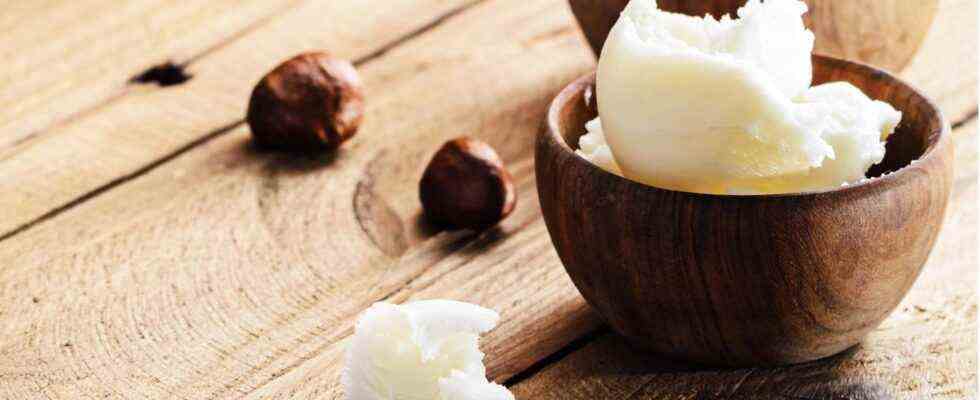natural product
What is shea butter, what is it made of and how do you use it?
Shea butter is a natural product that is widely used in the cosmetics industry
© OlgaLarionova / Getty Images
Whether hand cream, shower gel or body lotion: If you read the ingredients of common care products for the skin more closely, (un)refined shea butter is often listed in them. But what is actually behind it?
Shea butter is obtained from the fruits of the Karité tree, which is native to Africa. To be more precise, it is the nut-like kernels whose shells contain the coveted vegetable fat. For the production, the shea nuts must first be dried and peeled by hand to remove the pulp. The shells are then roasted in an oven and mashed with a mortar, mixed with water and beaten until a white-yellow mass of fat settles on the surface – and can be skimmed off. Only when this has cooled and hardened is unrefined shea butter spoken of. However, this is usually only found in (certified) natural cosmetics. Read the following to find out why.
Content: What is shea butter made of?
Shea butter smells slightly nutty, some also claim that the scent is reminiscent of chocolate. However, this most likely depends on the strain in question. It only retains its yellowish color if it remains unrefined, i.e. pure. In other words, if the shea butter is white, it has been refined for commercial processing. As a result, it no longer contains valuable beta-carotene (a precursor of vitamin A), which, among other things, is supposed to counteract natural skin aging. To the other ingredients of shea butterwho care for skin and hair include:
- allantoin: has an anti-inflammatory effect and is intended to counteract skin irritation. It also has wound-healing properties, which is why it is used to reduce scars.
- vitamin E (Tocopherol): is an antioxidant that the body cannot produce itself. It counteracts skin aging and promotes skin moisture.
- Linoleic acid: can soothe the skin and improve skin hydration. The essential omega-6 fatty acids strengthen the complexion and make it more resistant.
- oleic acid: is rich in vitamins and helps the skin to pass important ingredients through the skin’s natural barrier more easily.
- palmitic acid: supports the skin cells in binding moisture. For this reason, the ingredient should be particularly suitable for the care of dry skin.
- stearic acid: binds moisture. It is to be understood as a kind of film that covers the skin to protect it from external influences.
What are the benefits of shea butter?
Because in most products exclusively refined shea butter stuck, valuable ingredients are lost. Nevertheless, in a weakened form, as found in many cosmetic products (creams, lotions), it has positive properties:
- it has a moisturizing effect
- it moisturizes the skin
- it has a calming effect on the skin
- it is suitable for all skin types
- it is therefore very well tolerated
- it counteracts skin aging
- it supports cell regeneration
- it’s supposed to prevent stretch marks
Unrefined Shea Butter On the other hand, it not only has valuable beta-carotene, but should also be absorbed more quickly into the skin – without leaving a greasy film.
How to use shea butter correctly
As already mentioned at the beginning, shea butter is suitable for face, body and hair equally. Irrespective of whether you decide on a refined or unrefined product – the method of application remains the same: Always take only a small amount and distribute it evenly on the skin or, for example, in the ends of the hair. However, keep in mind that refined shea butter can leave a light greasy film on the skin, making it ideal for overnight use. Unrefined Shea Butter On the other hand, it absorbs more quickly into the skin and can also be used during the day without any problems.
Another tip: Shea butter can also be used as a bath additive. Add a small amount to the water and enjoy (and your skin) a nourishing full bath.
Important buying tips for shea butter
Refined shea butter often contains fragrances and preservatives. It is therefore advisable to only use unrefined products – especially if you have sensitive skin. In addition, shea butter can be contaminated with harmful substances if there is no corresponding certificate on the packaging. Pay attention when buying natural cosmetics in organic quality, recognizable by certificates such as this Natrue seal for natural and organic cosmetics. And the price is also an important indicator of good quality: If the shea butter comes directly from Africa, where it was painstakingly handcrafted, a particularly cheap bargain should make you suspicious. Of course, a high price is still no guarantee for fair working conditions and sustainable raw materials, so products with the Fairtrade seal are still the better choice.
You might also be interested in:
This article contains so-called affiliate links. Further information are available here.


